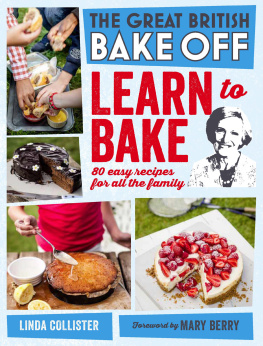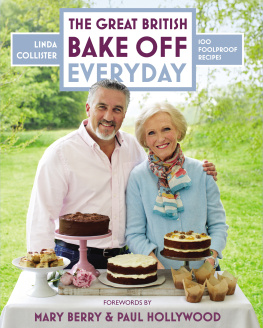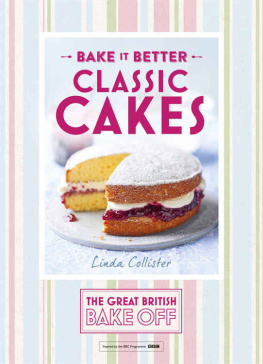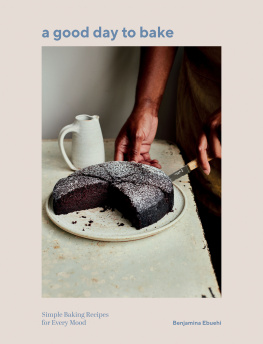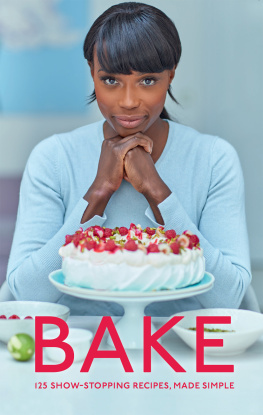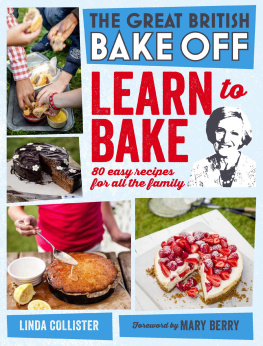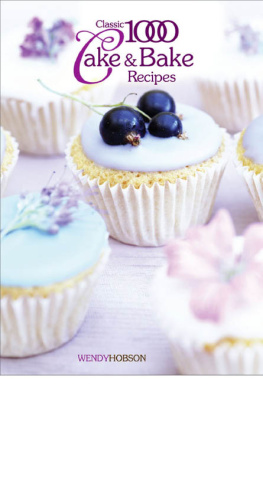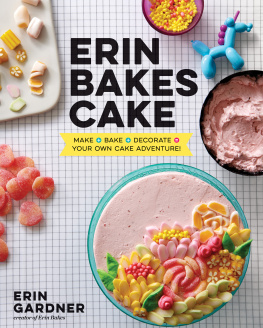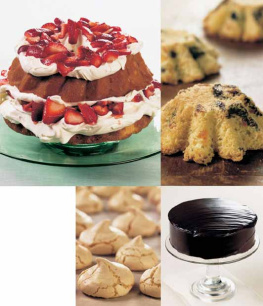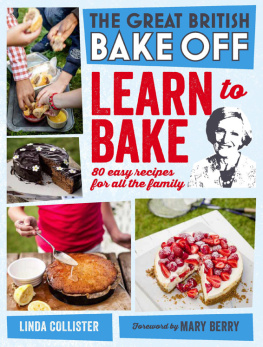CONTENTS
ABOUT THE BOOK
Love eating cake? Well, this weekend, get into the kitchen and make one yourself.
Baking is fun when you know how to do it, and you dont need lots of equipment or expensive ingredients.
Learn to Bake explains baking terms (how do you beat, fold or cream?) and special ingredients (what is strong bread flour?). Then it tells you everything you need to know to bake for every occasion and every person in your life.
Have a go at the recipes in this book with your friends and family get everyone involved, make a mess, have some fun and bake something to be proud of.
ABOUT THE AUTHOR
LINDA COLLISTER knows a lot about baking she is the author of The Great British Book of Baking, The Great British Bake Off: How to Bake and The Great British Bake Off: How to Turn Everyday Bakes into Showstoppers. In Learn to Bake, Linda takes all of the skills used in The Great British Bake Off and breaks them down for beginners.
LOVE PRODUCTIONS is the television production company that devised and makes the BAFTA award-winning The Great British Bake Off and Junior Bake Off.
LIST OF RECIPES
FOREWORD BY MARY BERRY
Welcome bakers! If youve never baked before, then well done for picking up this book and deciding to have a go. Hopefully you will see from the recipes here how much fun baking can be. Its a great, inexpensive hobby that can be incredibly rewarding and I should know, Ive been baking for work and pleasure for quite some time now!
All of the recipes are really easy to follow and you will soon be baking cakes, biscuits and breads, and delighting your family and friends.
A few of the recipes do need adult hands high temperatures and sharp knives can be tricky to manage by yourself. Mums and dads if youve never baked before, this is the perfect opportunity to join in too.
Whatever your age, just have a go, enjoy the experience, but the best reward is sharing your bakes with your friends and family they will just love you for it!
MARY BERRY
GETTING STARTED
If you have never made a cake before, this is the book for you. Learn to Bake is full of all the kinds of baking seen on The Great British Bake Off but made simple.
Our aim is to make baking easy to understand and fun. As Mary and Paul often say, baking does need to be precise, and baking-related terminology can be mystifying if its never been explained to you. So, this book is all about learning the basics.
We look at baking terms, ingredients and equipment, then some troubleshooting tips to help avoid baking mishaps.
But if you do have a baking disaster, dont be put off. It happens to everyone think about the soggy pastry cases and flat sponges that haunt The Great British Bake Off bakers. And its easy to improve just keep trying, learn how your oven works best, weigh your ingredients carefully and make notes for next time.
To get you started, the recipes in this book dont need fancy or expensive ingredients. In each chapter we look at the main techniques you need and guide you through, step by step.
In Cakes, we look at four baking methods. The first is the all-in-one method (a favourite of Mary Berry), where all the cake ingredients are added to one bowl and beaten until light and fluffy.
The second method is the creaming method. This one has a few more stages first you beat the soft butter and sugar together before folding in the eggs and flour.
In both methods, its all about getting air into the cake mixture to ensure the cake rises beautifully as it bakes.
The third method in this chapter is the melting method, where the butter and sugar are melted together before being mixed with the remaining ingredients. Its a technique most often used to make chewy, gooey recipes such as brownies and gingerbreads, and appears in later chapters too for making biscuits and flapjacks.
Finally, there is the whisking method. We use this to make light sponges such as Swiss Rolls, which are made from eggs, sugar and plain flour so no raising agents. The whisking develops the structure to ensure the sponge rises as it bakes.
Once youve got to grips with these methods, youll find they crop up again in many other types of baking.
Pastry and Bread have their own sets of techniques and terms, but once youve tried a simple pastry or bread recipe, they will make more sense. In Pastry, you will learn to how bake blind, and in Bread you will be kneading, proving, knocking back (or as Paul calls it, punching down) and working the dough.
Finally in Puddings, we tackle meringues, pancakes, cheesecakes and even souffls. Youll learn how to whisk egg whites into soft peaks and stiff peaks and then fold them to bake divine sweet treats.
Youll also see an * in the ingredients lists and recipe methods throughout the book. These black asterisks indicate that more information is available at the front of the book in Baking Terms Explained. If there is a page reference, there will also be step-by-step photos to help you as well. Once youve learned the technique, you wont need to cross-reference again (or youll just need to turn to the front every now and then to refresh your memory).
KEY BAKING INGREDIENTS
Most of these bakes use easy, simple ingredients and its worth keeping them in the store cupboard so youre always able to whip something up.
FLOUR
Plain flour is made from wheat with a low gluten content (one of the key ingredients for making bread). It is ideal for making sponges, cakes and pastries where you want a soft or crumbly light texture.
Self-raising flour is plain flour plus chemical raising agents. These produce bubbles of carbon dioxide gas when mixed with a liquid which make the mixture expand and rise in the heat of the oven. The structure of the flour then sets around the bubbles, trapping them, so you get light, spongy cakes.
If you only have plain flour, you can turn it into self-raising flour by mixing in baking powder (you will need 4 teaspoons for 230g of flour).
Plain and self-raising flour can be white, fine wholemeal (which contains tiny flecks of bran and bakes to a light brown colour) and spelt, a variation of wheat which has a nuttier taste and can be a creamy white or light brown colour.
Strong bread flour is what you should use for bread making because it has extra gluten. When you work bread dough, the gluten becomes stretchy. As the yeast in bread makes air bubbles, the bread grows and the stretchiness of the gluten gives the dough strength to rise. Look out for wholemeal and spelt, as well as flours with added grains and flakes, or malted wheat, which add extra flavour, texture and colour to bread doughs.
Cornflour is not made from wheat, but is a fine white powder made from corn. It makes biscuits and cakes lighter and is also used to thicken sauces and fillings.
SUGAR
Caster sugar (white or golden) is the best sugar to use for baking cakes and cookies, as the tiny crystals break down easily during creaming and beating.
Granulated sugar has much larger crystals, which are less easily dissolved, and these can give your sponge a speckled look, and pastry or cookies a gritty texture.
Soft light and dark brown muscovado sugars have not been as heavily refined (processed), as caster and granulated sugar, so they add a toffee flavour to cake mixtures. But they can also make cakes heavy as they are much more moist.
Next page
